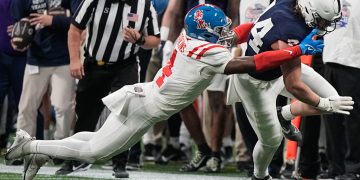“Say it loud: I’m Black, and I’m proud,” university students and officials chanted as they marched from Lamar Hall to where the Confederate monument once stood in the Circle. Over two dozen university community members gathered on Tuesday afternoon to commemorate Black History Month with the annual Black History Month March.
This year’s march was strikingly different from those that took place over the past two years. In 2019 and 2020, the university’s Confederate monument was a central focus, and now, it is gone from the center of campus.
“Look at where we are standing. Last year, we marched from Lamar Hall to this very place with this degrading Confederate statue standing right here, going against everything that the university says it stands for — equity, diversity (and) inclusiveness,” said Demetrius Harris, president of UM’s chapter of the National Association for the Advancement of Colored People (NAACP). “Now, we are standing in the absence of racism, oppression and bigotry.”
Once they reached the Circle, student leaders celebrated the relocation of the Confederate monument while speaking about the changes they have witnessed in Oxford and the United States as a whole over the past year.
“I kind of get emotional just looking at this circle,” Tyler Yarbrough said. “I think a lot of people don’t understand how dangerous that statue really was and what it effectively did to a people.”
Yarbrough, a senior public policy leadership major, also spoke about the history of slavery and racism on the campus.
“That building, (the Croft Institute), was built by enslaved African-American workers,” he said. “The Lyceum was built by enslaved African-American workers. How many buildings are named after a Black person on this campus? I think it’s dangerous when you can come on this campus and look at the buildings and the physical landscape, and you don’t have any memory or knowledge of (slavery).”
Last week, the Associated Student Body passed a resolution urging university administration to support the creation of a student ambassador program for campus slavery tours. Yarbrough said that he is proud that ASB passed the bill, and he hopes that the history of slavery will become common knowlege to everyone.
DeArrius Rhymes, founder and vice chair of the Black Caucus, said he believes that the march this year should serve as an important moment in UM history.
“Two years ago, we marched during Black History month silently,” Rhymes said. “Two years ago, Mississippi had a flag that hung high over our heads and constantly damned an entire race of people. Two years ago, we had a tall, disgusting, manipulative piece of marble that stood right here. Today, when you look at the center of our campus, you see history has been manifested.”
This year’s march was organized by The Black Coalition, which is made up of 12 prominent Black student organizations.
Kiana Gleeton, a sophomore chemical engineering major, said that the annual march is important because it highlights Black people at the university and the things they have done to keep UM moving forward. She also said she wants people to understand that it is important to feature Black voices throughout the year.
“We’re not just important during one month,” Gleeton said. “We’re important year-round.”
Shelby Smith, a full-time missionary with Chi Alpha Campus Ministries, said she participated in the march as an ally because she loves her Black brothers and sisters. Smith said she believes that she can use her privilege as a white woman to advance diversity and inclusion in the community.
“From my perspective, I think (the university) hasn’t progressed enough,” Smith said. “I came here in 2015 when the situation with the flag was happening. Four years later, we just got the statue removed. Every step is a step, but I think we need to take two steps at a time.”
NAACP president Harris also spoke of James Meredith, the first African-American student to integrate into the university, and how he paved the way for other Black students to attend school here.
“James Meredith was a blessing to us all,” Harris said. “Meredith dared to integrate the University of Mississippi, which is why we are all standing here today. He was a revolutionary who crawled, so we can walk. Now, let us put in the work, so the next generation can run.”
Some students believe that the university has significantly moved forward when it comes to equity, diversity and inclusivity, and they celebrate the progress that has been made.
“Today, we marched not because we have been suppressed, overlooked, underrepresented or pushed to the side,” Rhymes said. “Today, we marched with a new purpose and a greater mission. We have more challenges ahead of us, more barriers to break down and more things to change for the greater good, but today, we march as champions, in the name of progress.”
The organizations that organized the march were The Black Caucus (UMBC), National Association for the Advancement of Colored People (NAACP), Black Student Union (BSU), Men of Excellence (MOX), Educated, Successful, Talented, Evolving, Empowered and Motivated (ESTEEM), National Pan-Hellenic Council (NPHC), Black Gospel Choir, Minority Association of Pre-Medical Students (MAPS), Increasing Minority Access to Graduate Education Program (IMAGE), National Society of Black Engineers (NSBE), National Association of Black Accountants (NABA) and the Undergraduate Black Law Students Association (UBLSA).



























